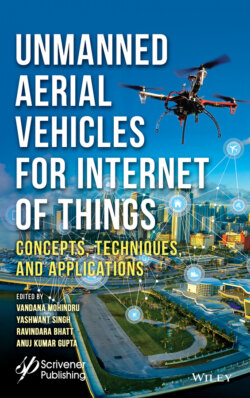Читать книгу Unmanned Aerial Vehicles for Internet of Things (IoT) - Группа авторов - Страница 51
2.1 Introduction
ОглавлениеOn account of their high mobility and their capability of being deployed easily, on-demand UAVs have been used in a wide range of applications like in the military, telecommunication, surveillance and monitoring, rescue operations, and so on [1, 2]. They have played a vital role in numerous applications spanning over various areas of human life. UAVs have been envisioned to support various applications in 5G wireless networks [3–5]. Over the past 40 years, UAV-centric research has focused on a wide range of issues in UAV assisted wireless networks. Work is still continuing and new applications with their own challenges and solutions are being explored daily. Compared to the terrestrial communication systems, these on-demand UAV networks have to be critically designed considering the non-stationary channels, high mobility of the UAV-user equipment, and the UAV-base station, energy and altitude constraints, and the various environmental factors affecting system performance. UAV-assisted wireless communication is a promising application for the next generation networks which are looking forward to the Internet of Things (IoT) era. As we move towards a heterogeneous communication network, the complexity in designing such networks is increasing by leaps and bounds. Here, in this article, effort has been made to bring forth the state of art and the challenges posed in designing UAV-assisted networks. Some of the open research areas identified are channel modeling of A2G links considering the communication over water bodies and highy urban scenarios, effects of higher doppler shifts in A2A links of UAV-mmWaves network, better effective interference mitigation techniques to deal with UAV-BS channel in UAV-cellular network, efficient spectrum sharing schemes for increasing network throughput and spectral efficiency of UAV-mmWave communication network, trajectory optimization, on-board energy requirements of UAVs and multidimensional UAV channel modeling. Need arises to explore more areas of this cutting edge technology of next generation communication networks. As work progresses in this area, researchers will come across more challenges to deal with.
